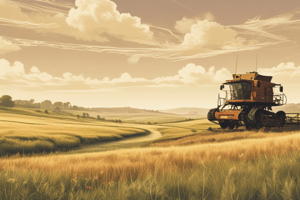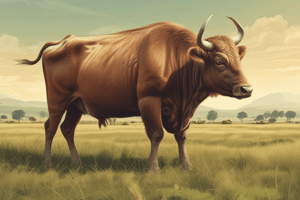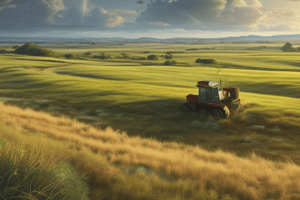Podcast
Questions and Answers
What is the term used to describe the measurement of how pleasant the grass is to taste?
What is the term used to describe the measurement of how pleasant the grass is to taste?
- Digestibility
- Palatability (correct)
- Dry Matter Intake
- Productivity
What type of grassland is characterized by little variability in botanical composition?
What type of grassland is characterized by little variability in botanical composition?
- Rough Mountain/Hill Grazing
- Permanent Grassland
- Leys (correct)
- Poor quality growth
What is the process by which the stem of the grass develops?
What is the process by which the stem of the grass develops?
- Vegetative
- Reproduction
- Tillering
- Elongation (correct)
Which type of clover is often used in grassland?
Which type of clover is often used in grassland?
What is the unit of measurement used to determine the amount of grazing and winter fodder required on a farm?
What is the unit of measurement used to determine the amount of grazing and winter fodder required on a farm?
What is the stage of grass growth where seed heads emerge?
What is the stage of grass growth where seed heads emerge?
What is the term used to describe the proportion of food that can be assimilated and used by the body?
What is the term used to describe the proportion of food that can be assimilated and used by the body?
What type of grassland is characterized by a low stocking rate and low production levels?
What type of grassland is characterized by a low stocking rate and low production levels?
What is the ideal pH range for growing kale?
What is the ideal pH range for growing kale?
What is the main advantage of using kale as a fodder crop?
What is the main advantage of using kale as a fodder crop?
What is the main disadvantage of grazing kale in situ?
What is the main disadvantage of grazing kale in situ?
What is the purpose of strip grazing when using kale as a fodder crop?
What is the purpose of strip grazing when using kale as a fodder crop?
What is the disease that affects kale and eats holes in the stem, leaves, and cotyledons?
What is the disease that affects kale and eats holes in the stem, leaves, and cotyledons?
What is the method of controlling Club Root disease in kale?
What is the method of controlling Club Root disease in kale?
What is the advantage of kale as a cover crop?
What is the advantage of kale as a cover crop?
When is kale typically used as a fodder crop?
When is kale typically used as a fodder crop?
What is the primary purpose of planting a cover crop?
What is the primary purpose of planting a cover crop?
What is the main difference between a cash crop and a catch crop?
What is the main difference between a cash crop and a catch crop?
What is the benefit of ploughing a catch crop back into the soil?
What is the benefit of ploughing a catch crop back into the soil?
What is the term for a crop grown solely for energy production?
What is the term for a crop grown solely for energy production?
What is the growth cycle of kale characterized by?
What is the growth cycle of kale characterized by?
What is the primary use of kale as a catch crop?
What is the primary use of kale as a catch crop?
What is the advantage of planting a catch crop like kale?
What is the advantage of planting a catch crop like kale?
What is the main difference between a catch crop and an energy crop?
What is the main difference between a catch crop and an energy crop?
Study Notes
Grassland Types
- Rough mountain/hill grazing: poor quality growth, peaty soil, difficult to cultivate, improved by liming and reseeding
- Permanent grassland: variable botanical composition, low stocking rate, low production levels, land is never ploughed
- Leys: fertilised and limed to maintain quality, variable botanical composition, medium stocking rate, medium production levels
- Sown for grazing: temporary and reseeded often, little variability in botanical composition, high stocking rate, high production levels
Growth of Grass
- Vegetative growth: tillers grow
- Elongation: stem develops
- Reproduction: seed head emerges
- Growth rate: slow to begin, rapid growth, slows during reproductive phase
- Palatability: measures pleasantness to taste
- Productivity: measures quantity of herbage produced
- Digestibility: proportion of food assimilated by the body
- Dry Matter (DM): matter remaining after water removal
- Dry Matter Digestibility (DMD): percentage of DM that can be digested
- Dry Matter Intake (DMI): amount of feed consumed, excluding water content
Seed Selection
- Perennial RyeGrass
- Italian RyeGrass
- White Clover
- Red Clover
Grazing
- Livestock Units (LU): measure of livestock grazing, equivalent to one dairy cow or one suckler cow
- 1 LU = 12 tonnes of herbage annually
- Conversion rates: 1 dairy/suckler cow = 1.0 LU, Yearlings = 0.6 LU
Crop Types
- Cover crop: planted to cover soil, manages soil erosion, fertility, quality, water, weeds, pests, diseases, biodiversity, and wildlife
- Cash crop: grown to sell for profit
- Catch crop: fast-growing crop grown between successive plantings of a main crop, usually for animal feed, can improve soil structure
- Energy crop: low-cost and low-maintenance crop grown solely for energy production
Kale Production
Growth Cycle
- Soil suitability: free-draining loam or sandy soil, pH 6-7
- Sown: April – July
- Growing time: 5-6 months
- Use: grazed as a fodder crop
Harvesting and Storage
- Harvesting techniques:
- Zero grazing (crop cut by farmer and brought to housed animals)
- Strip grazing (most popular, but land must be suitable to avoid poaching)
- Storage methods:
- Ensiling (baled as ‘kaleage’)
- Grazed in situ by cattle or sheep using a strip grazing system
Advantages and Disadvantages
Advantages
- Reduces winter feed costs
- May reduce winter housing costs
- Reduces labour and machinery requirement
- High crude protein
- Acts as a cover crop:
- Prevents soil erosion
- Reduces nitrogen leaching
- Increases soil organic matter
- Contributes to biodiversity
Disadvantages
- Vulnerable to attack from pests and diseases
- Risk of poaching land if grazed in situ
Pests and Diseases
Pests
- Club Root:
- Soil-borne fungus (spores remain in soil for 20 years)
- Roots swell and prevents crop from absorbing nutrients and water
- Controlled by:
- Crop rotation
- Avoid growing kale in fields with club root history
- Planting resistant varieties (e.g. Caledonian)
Diseases
- Flea Beetle:
- Eats holes in stem, leaves and cotyledons at emergence
- Common in warm, dry conditions and slow growing crops
- Controlled by:
- Contact insecticide
Studying That Suits You
Use AI to generate personalized quizzes and flashcards to suit your learning preferences.
Description
This quiz covers the different types of grasslands, their characteristics, and management practices. Learn about rough mountain grazing, permanent grassland, leys, and more.




